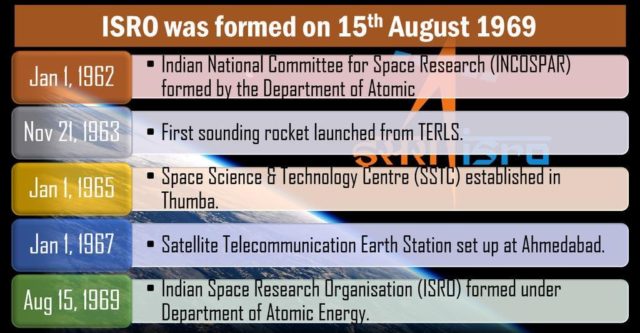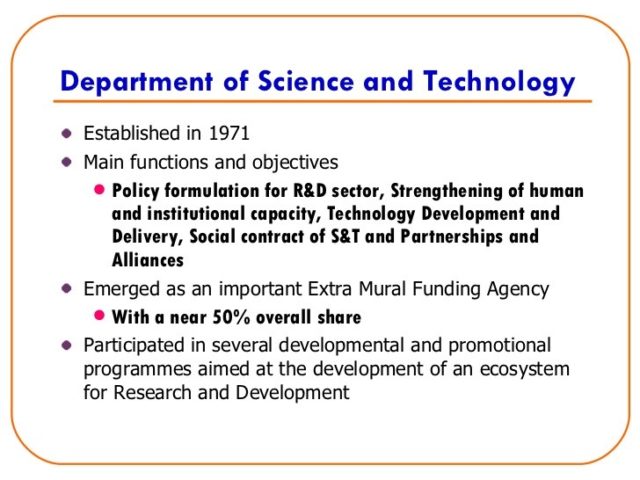PREVIOUS
Science and Technology in Modern India - I
May 17 , 2019
2435 days
15016
0
- India is a developing country with the second largest population.
- Nevertheless, for a developing country, like India, scientific and technological development is a necessity.
- Even though India was a pioneer in the field of science and technology 1500 years ago, it had lost its glory by the time of independence.
- After independence, Jawaharlal Nehru initiated reforms to promote higher education and science and technology in India.
- On that time, he understood that India had not been at the forefront of the Industrial Revolution.
- Hence he made an effort to promote higher education, and science and technology in India.
Foundation for Research and Development
- The Council of Scientific and Industrial Research (CSIR) as an autonomous body was came into operation on 26 September 1942.
- Initially the following 8 National Laboratories were established under CSIR
- National Chemical Laboratory - Pune
- National Physical Laboratory - New Delhi
- National metallurgical laboratory - Jamshedpur
- Central Fuel Research Institute - Jharkhand
- Central Drug Research Institute - Lucknow
- Central Glass and Ceramics Research Institute - Kolkata
- Central Leather Research Institute - Chennai
- Central Electro Chemical Research Institute - Karaikudi in Tamil Nadu.
- All the Eight establishments were initiated during 1940-50s.
- The Indian Institute of Technology (IIT) was conceived by a 22-member committee of scholars and entrepreneurs in order to promote technical education.
- First IIT was inaugurated on 18 August 1951 at Kharagpur in West Bengal.
- More IITs were soon opened in Bombay, Madras, Kanpur, and Delhi as well in the late 1950s and early 1960s.
- Department of Atomic Energy was established in 1954 by a Presidential Order.
- With the cooperation from the Soviet Union, Defence Research and Development Organisation (DRDO) was set up in 1958 for the advanced military technology.
Indian National Committee for Space Research
- The Indian National Committee for Space Research (INCOSPAR) was set up in 1962 by Jawaharlal Nehru under Dr. Vikram Sarabhai to formulate the Indian Space Programme.
- Later it was superseded by the Indian Space Research Organisation (ISRO) in 1969, August 15.

Department of Science & Technology (DST)
- Department of Science & Technology (DST) was established in May 1971 and functions under the ambit of the Ministry of Science and Technology.
- The department functions with an objective of promoting new areas of Science & Technology.
- It acts as a nodal department for organizing, coordinating and promoting S&T related activities in the country.

Science and Technology in 5-year plan
- Planning Commission (1950) fixed investment levels, prescribed priorities, divided funds between agriculture and industry, and divided resources between the state and the federal governments.
- Formulating five-year plans was the ultimate responsibility of this commission.
- It includes various schemes for the promotion of Science and Technology in almost all the five-year plans.
- During the second five-year plan (1956-1961) skilled manpower committee organised to find out the skilled persons.
- Voluntary based registration of technically skilled persons was conducted but it failed to achieve its aim.
- Later in 1961 these skill details were obtained from census.
- During the 3rd five-year plan (1961-1966) the government planned to develop two type of research viz. Pull and push research.
- Pull research was the research which is made in academic sector.
- Push research was the research which is made in the industries and laboratories.
- 4th and 5th five-year plan (1969-1974 & 1974-1979) focused on the creation of the following two scientific bodies which can operate out of CSIR control.
- Indian Atomic Energy Regulatory Board
- Indian Space Research Board
- The seventh five-year plan (1985 -1990) is considered as a mother of modern-day invention in S&T Sector.
- During this period only the Nano technology, Information technology, robotic technology and etc were developed.
- The Eighth five-year plan (1992 -1997) aimed to promote privatisation of R&D and Non-strategic areas of Science and technology except Nuclear, Defence and space.
- During the 10th five-year plan (2002-2007) focus was concentrated on integration of academic and industries.
- For this purpose, they formed Industrial Science and Technology Interfacing Institution (ISTIIS).
- The DAE (Department of Atomic Energy) contributed significantly to international mega-science projects during this period, particularly the CERN.

- This contribution has been recognized and glorified by the international scientific community.
- During the eleventh five-year plan (2007-2012) the government declared the entire decade (2010-2020) as an innovation decade.
- Also, it aims to gender parity in R&D.
- India’s Major problem for scientific development is significant brain drain.
- The 12th five-year plan (2012-2017) aims to promote innovation as well as mitigate the Brain drain.
- It also focuses on the following points in science and technology
- Creation and development of national facilities in the field of R&D
- Emphasis on partnership growth of Science and Technology
- Large scale investment into mega science project aimed at the creation of the research and development infrastructure in India as well as abroad (under partnership)
- - - - - - - - - - - - - -
Leave a Reply
Your Comment is awaiting moderation.


